This is an old revision of this page, as edited by Averysoda (talk | contribs) at 17:14, 24 June 2015 (Not supported by source, such an interpretation is WP:OR. Lapid never said that. He said: "The photo of an elderly Palestinian woman searching through rubble reminded me of my grandmother who died in Auschwitz." Lapid makes no mention of "IDF actions"). The present address (URL) is a permanent link to this revision, which may differ significantly from the current revision.
Revision as of 17:14, 24 June 2015 by Averysoda (talk | contribs) (Not supported by source, such an interpretation is WP:OR. Lapid never said that. He said: "The photo of an elderly Palestinian woman searching through rubble reminded me of my grandmother who died in Auschwitz." Lapid makes no mention of "IDF actions")(diff) ← Previous revision | Latest revision (diff) | Newer revision → (diff)| Carlos Latuff | |
|---|---|
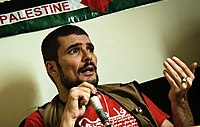 Carlos Latuff in 2012 Carlos Latuff in 2012 | |
| Born | Carlos Latuff (1968-11-30) November 30, 1968 (age 56) Rio de Janeiro, Brazil |
| Nationality | Brazilian |
| Known for | Political cartoons, Social commentary |
| Movement | Anti-globalization, anti-capitalism, anti-imperialism, anti-racism, anti-fascism, anti-Americanism, anti-Zionism, Marxism, socialism, feminism, indigenous rights |
Carlos Latuff (born November 30, 1968) is an Arab Brazilian freelance political cartoonist. His works deal with an array of themes, including anti-Zionism, anti-globalization, anti-capitalism, and anti-U.S. military intervention. He is best known for his images depicting the Israeli–Palestinian conflict and, more recently, the Arab Spring events. Latuff himself has described his work as controversial.
Early life
Latuff was born in São Cristóvão (Rio de Janeiro), Brazil, and is of Lebanese ancestry; in his own words he said he has "Arab roots".
Published works
Latuff's works have been posted mostly by himself on Indymedia websites and private blogs. However, some of them have been picked up and featured in magazines such as the Brazilian edition of Mad, Le Monde Diplomatique and the The Toronto Star. In addition, a few of his works were published on Arab websites and publications such as the Islamic Front for the Iraqi Resistance (JAMI) magazine, the Saudi magazine Character, the Lebanese newspaper Al Akhbar, among others.
Themes
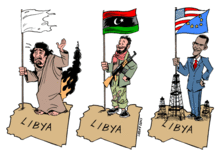
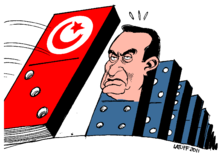
A vast number of Latuff's cartoons are related to the Israeli-Palestinian conflict, which according to Latuff : "became important to Latuff after he visited the area in the late 1990s." These cartoons are heavily critical of Israel and have drawn criticism and allegations of uninhibited utilization of "judeophobic stereotypes in the service of the anti-globalisation movement."
In his We are all Palestinians (Template:Lang-ar) cartoon series, various famous oppressed groups, including Jews in the Warsaw Ghetto, Black South Africans during Apartheid, Native Americans, and Tibetans in China, are all shown stating "I am Palestinian."
Latuff has also made a series of cartoons that portray Israeli Prime Minister Ariel Sharon, United States President George W. Bush, Brazilian president Luiz Inácio Lula da Silva and British PM Tony Blair among other politicians as monsters and as Nazis.
Latuff is also critical of US military action in Iraq and Afghanistan. He has made promotional cartoons for anti-US militancy as well as cartoons alleging US actions have been motivated by the chance of making profit from oil. Among the cartoons, there are also some that portray US soldiers as severely wounded, dead, or paraplegic or as harming Iraqi civilians.
In his comic series Tales of Iraq War (Template:Lang-ar) he portrays "Juba, the Baghdad sniper", an Iraqi insurgency character claimed to have shot down several dozen US soldiers, as a "superhero". He has also made a caricature of US President George W. Bush laughing over US casualties.
Since the end of 2010, he has been consistently engaged in producing cartoons about the Arab Spring in which he openly sided with the revolutionaries. After the victory of revolutions in Tunisia, Egypt and Libya his cartoons about these countries have focused on the menace of counter-revolution or Western interference. Some of his cartoons have been displayed in mass demonstrations in Arab countries.
Alleged antisemitism
| The neutrality of this article is disputed. Relevant discussion may be found on the talk page. Please do not remove this message until conditions to do so are met. (May 2014) (Learn how and when to remove this message) |
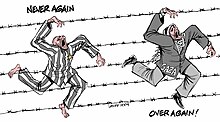



The notability of Latuff and his cartoons has drawn criticism from individuals and organizations, especially in the form of accusations of antisemitism.
His works were criticized by a writer for the Institute for Global Jewish Affairs, part of the Jerusalem Center for Public Affairs (an Israeli NGO), for allegedly containing antisemitism and antisemitic motifs.
In 2002 the Swiss-based Holocaust survivors organization Aktion Kinder des Holocaust sued the Indymedia of Switzerland on the charge of antisemitism for publishing Latuff's cartoon titled We are all Palestinians series in their website, which depicted a Jewish boy in the Warsaw Ghetto saying: "I am Palestinian." The criminal proceedings were suspended by Swiss court.
In their 2003 Annual Report, the Stephen Roth Institute compared Latuff's cartoons of Ariel Sharon to "the antisemitic caricatures of Philipp Rupprecht in Julius Streicher's Der Stürmer." The SRI also complained over a cartoon showing Argentinian revolutionary Che Guevara in a Palestinian keffiyeh.
In 2006, Latuff placed second for his cartoon comparing the West Bank barrier with the Nazi concentration camps, in the Iranian 'International Holocaust Cartoon Competition'. Latuff's entry was described as "Holocaust inversion," a "motif" of antisemitism, by Manfred Gerstenfeld.
Joel Kotek, a professor at Belgium’s Free University of Brussels, in his book Cartoons and Extremism calls Latuff “the contemporary Drumont of the internet.” Eddy Portnoy, in The Jewish Daily Forward, reviewing the book, writes that this is clearly not correct, and that "it is a disservice to the fight against genuine antisemitism to have included ".
Latuff's response to allegations of antisemitism
In an interview with the Jewish-American weekly newspaper The Forward in December 2008, Latuff responded to charges of antisemitism and the comparisons made between his cartoons and those published in Der Stürmer in Nazi Germany:
My cartoons have no focus on the Jews or on Judaism. My focus is Israel as a political entity, as a government, their armed forces being a satellite of U.S. interests in the Middle East, and especially Israeli policies toward the Palestinians. It happens to be Israeli Jews that are the oppressors of Palestinians... My detractors say that the use of the Magen David in my Israel-related cartoons is irrefutable proof of antisemitism; however, it’s not my fault if Israel chose sacred religious motifs as national symbols, such as the Knesset Menorah or the Star of David in killing-machines like F-16 jets.
Latuff also stated that anti-Semitism is real, that anti-Semites like European neo-Nazis, "hijack" the Palestinian cause to bash Israel. To assert, however, that anti-Zionism is anti-Semitic is, in his view, "a well-known tactic of intellectual dishonesty." He said that cartoonists work by metaphors and analogies between the Jews in the Holocaust and suffering at the hands of the IDF among Palestinians. The use of cartoons insulting Muslims by depicting Muhammad as a bomber is defended as "freedom of speech", while using the Holocaust in drawings is deplored as "hatred against the Jews".
Latuff was included in Simon Wiesenthal Center's 2012 Top Ten Anti-Israel/Anti-Semitic Slurs list, which he considered "a joke worthy of a Woody Allen movie". He also claimed that Zionist lobbying groups try to associate him with well-known extremists and racists in order to disqualify his criticism of the Israeli government. According to him, "criticism or even attacks to the polity known as Israel do not mean hatred towards Jews because the Israeli government does not represent the Jewish people just as no government represents the totality of its people". He also pointed out that figures such as José Saramago, Desmond Tutu and Jimmy Carter were also accused of being antisemitic, saying that he was "in good company".
Gallery
-
 Latuff equating Gaza with a Nazi Ghetto and Israeli soldiers as SS soldiers
Latuff equating Gaza with a Nazi Ghetto and Israeli soldiers as SS soldiers
-
 "GazaGhetto" equates Israeli soldiers with Nazi troops during the Warsaw Ghetto Uprising
"GazaGhetto" equates Israeli soldiers with Nazi troops during the Warsaw Ghetto Uprising
-
 Creation of a suicide bomber
Creation of a suicide bomber
-
 Latuff's cartoons are often used in protests. This demonstration was against Folha de S. Paulo's usage of the term "ditabranda" to describe the Brazilian military dictatorship (1964–1985)
Latuff's cartoons are often used in protests. This demonstration was against Folha de S. Paulo's usage of the term "ditabranda" to describe the Brazilian military dictatorship (1964–1985)
-
 'Global Intifada' by Latuff shows a 'global persona' wearing a Keffiyeh, making the V (victory) sign with the left hand and holding a slingshot in the right hand, in front the Palestinian flag
'Global Intifada' by Latuff shows a 'global persona' wearing a Keffiyeh, making the V (victory) sign with the left hand and holding a slingshot in the right hand, in front the Palestinian flag
-
 'Uncle Sam wants you DEAD!' by Latuff shows Adolf Hitler with Uncle Sam's top-hat (representing the United States) and a Nazi swastika atop it
'Uncle Sam wants you DEAD!' by Latuff shows Adolf Hitler with Uncle Sam's top-hat (representing the United States) and a Nazi swastika atop it
-
 'Just following orders' by Carlos Latuff shows Nazi SS members compared to Israeli soldiers described as "born to kill". Text in the shape of a Nazi swastika says: "Israeli soldiers are just following orders"
'Just following orders' by Carlos Latuff shows Nazi SS members compared to Israeli soldiers described as "born to kill". Text in the shape of a Nazi swastika says: "Israeli soldiers are just following orders"
-
 A 2002 cartoon by Latuff depicting Marxist revolutionary Che Guevara wearing a Palestinian keffiyeh
A 2002 cartoon by Latuff depicting Marxist revolutionary Che Guevara wearing a Palestinian keffiyeh
-
 A 2003 cartoon by Latuff depicting Che Guevara wearing a Jewish Kippah.
A 2003 cartoon by Latuff depicting Che Guevara wearing a Jewish Kippah.
-
 Israeli Palestinian sides
Israeli Palestinian sides
-
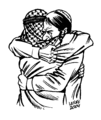 Picture "forgiveness", depicts the reconcilement of a Jew and an Arab Palestinian.
Picture "forgiveness", depicts the reconcilement of a Jew and an Arab Palestinian.
-
 A poster for Saudi Arabia's #women2drive Movement.
A poster for Saudi Arabia's #women2drive Movement.
-
 SCAF being the Judge, jury and executioner.
SCAF being the Judge, jury and executioner.
-
 Superman killed in action in Iraq
Superman killed in action in Iraq
-
 Bashar al-Assad seated on top of a volcano called Syria.
Bashar al-Assad seated on top of a volcano called Syria.
-
 War in Afghanistan
War in Afghanistan
-
 SCAF hypnotizing
SCAF hypnotizing
-
 The Great Satan
The Great Satan
-
 IsraHell, Burning Buses
IsraHell, Burning Buses
Prizes
- International Holocaust Cartoon Competition - shared second prize.
References
- ^ "UAE General, Brazilian artist lives up to his promise". Gulfnews.com. 2009-01-18. Retrieved 2013-01-25.
- Interview with Latuff "Carlos Latuff: Cartoonist and opinion-maker", Menassat, 2008
- Trigo, Luciano. "‘Imagens podem ser apropriadas por qualquer um’, diz Carlos Latuff." G1 (O Globo). 25 January 2013. Retrieved on June 18, 2014. "nascido no subúrbio carioca de São Cristóvão:" (Carioca means from Rio de Janeiro)
- "Mad magazine, January 2009, Brazilian edition". Latuff2.deviantart.com. Retrieved 2013-01-25.
- "Charge q fiz sobre deportação d ciganos por Sarkozy no Le Mon... on Twitpic". Twitpic.com. Retrieved 2013-01-25.
- Mafaz Al-Suwaidan Special to the star (2008-05-30). "The Toronto Star: More than just a chic checkered scarf". Thestar.com. Retrieved 2013-01-25.
- Interview for JAMI magazine
My cartoons in Saudi Arabia magazine
Article about my art in the Lebanese newspaper "Al Akhbar"
Cartoon reproduced in Iraqi magazine - ^ "The Jewish Daily Forward: Simple, Offensive and Out There". Forward.com. Retrieved 2013-01-25.
- Black, Ian (19 December 2008). "Cartoon symbols of the Israeli-Palestinian conflict". London: The Guardian. Retrieved 2009-07-07.
- "Carlos Latuff: "We Are All Palestinian"". Sinkers.org. Retrieved 2013-01-25.
- "Ariel Sharon portrait by ~latuff". DeviantArt. 2003-06-08. Retrieved 2007-09-21.
- "Ariel Sharon by ~latuff". DeviantArt. 2003-06-07. Retrieved 2007-09-21.
- "The Godfather by ~latuff". DeviantArt. 2003-05-02. Retrieved 2007-09-21.
- — Lorenzo Kom'boa Ervin (1995-01-23). "The Cartoons of Carlos Latuff". Infoshop.org. Retrieved 2014-08-10.
{{cite web}}: CS1 maint: multiple names: authors list (link) - "Friday the 13th Jason Sharon by ~latuff on DeviantArt". DeviantArt.com. 2003-06-08. Retrieved 2013-01-25.
- http://brasil.indymedia.org/images/2004/05/279977.gif
- http://brasil.indymedia.org/images/2003/08/260245.gif
- http://brasil.indymedia.org/images/2004/09/289838.gif
- Carlos Latuff. "TALES OF IRAQ WAR by LATUFF". tales-of-iraq-war.blogspot.com.
- Carlos Latuff. "TALES OF IRAQ WAR by LATUFF". tales-of-iraq-war.blogspot.com.
- Carlos Latuff. "TALES OF IRAQ WAR by LATUFF". tales-of-iraq-war.blogspot.com.
- "Interview with Carlos Latuff". Latuff2.deviantart.com. Retrieved 2013-01-25.
- http://www.infoshop.org/graphics/Latuff3/Anti-America/Laughs.gif.html
- Grudgings, Stuart (2011-08-29). "Rio cartoonist inspires Arab rebellions from afar". Reuters.com. Retrieved 2013-01-25.
- "Latuff's cartoon displayed in Tahrir Square". Twicsy.com. 2011-08-01. Retrieved 2013-01-25.
- "Stop military tribunals". Arabawy.org. Retrieved 2013-01-25.
- Adam Levick, September 2, 2010 (2010-09-02). "Anti-Semitic Cartoons on Progressive Blogs Adam Levick". Jcpa.org. Retrieved 2013-01-25.
{{cite web}}: CS1 maint: multiple names: authors list (link) CS1 maint: numeric names: authors list (link) - Alex Schärer: Linke und Antisemitismus: Der Indymedia-Streit - Aufpassen, was im Kübel landet, Die Wochenzeitung, April 4, 2002
- Junge Welt: Ärger im Internet: Wegen antisemitischer Beiträge hat Indymedia Schweiz den Betrieb gestoppt, February 25, 2002
- Aktion Kinder des Holocaust: Is this cartoon by Latuff, published at indymedia-switzerland, anti-Semitic? An analysis
- Hamadeh, Anis (August 2002). "Jewish peace activists and Israeli violence". Retrieved 2007-09-21.
- "General Analysis: Overview". Annual Report. Stephen Roth Institute. 2003. Retrieved January 10, 2010.
- "Brazil 2003-2004". Country Reports. Stephen Roth Institute. 2003. Retrieved June 7, 2010.
- Winners of the Iranian Holocaust Cartoon Competition, IRANCARTOON International
- "Ahmadinejad, Iran, and Holocaust Manipulation: Methods, Aims, and Reactions". Jerusalem Center For Public Affairs. Archived from the original on 28 July 2012.
- Manfred Gerstenfeld: "Ahmadinejad, Iran, and Holocaust manipulation: methods, aims, and reactions", Scholars For Peace in the Middle East, February 1, 2007
- Cartoons and Extremism: Israel and the Jews in Arab and Western Media By Joel Kotek Vallentine Mitchell, 201 pages
- "Simple, Offensive and Out There Extreme Cartoons Distort Israel and the Jews By Eddy Portnoy". Forward.com. Retrieved 2013-01-25.
- ^ "Latuff: Cartoonist in Conversation - Forward.com". www.forward.com. Retrieved 2008-12-21.
- "2012 Top Ten Anti-Israel/Anti-Semitic Slurs" (PDF). Simon Wiesenthal Center. Retrieved 2012-12-28.
- "Cartunista brasileiro está no ranking dos "dez mais antissemitas" do mundo" (in Portuguese). Opera Mundi. Retrieved 2012-12-28.
- "Ahmadinejad, Iran, and Holocaust Manipulation: Methods, Aims, and Reactions". Jerusalem Center for Public Affairs. February 1, 2007. Archived from the original on September 16, 2012. Retrieved September 16, 2012.




